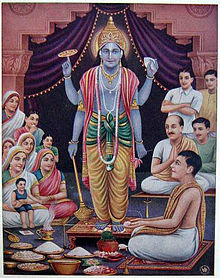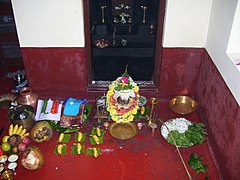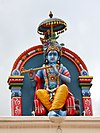Satyanarayana Puja

The Satyanarayana Puja is a puja (religious ritual worship) dedicated to the Hindu god Vishnu, who is also known as Satyanarayana.
The puja is described in the Skanda Purana,[1] a medieval era Sanskrit text.[2][3] According to Madhuri Yadlapati, the Satyanarayana Puja is an archetypal example of how "the Hindu puja facilitates the intimacy of devotional worship while enabling a humble sense of participating gratefully in a larger sacred world".[4]
The Puja
[edit]According to Munshi Abdul Karim, in Baghdad during the reign of the caliph Al-Muqtadir there was a Persian Sufi named Mansur Hāllāj who would repeat the phrase "Ānal Haq" or "I am truth", even after he was killed by the caliph, cut into pieces, and burnt into ash. Karim states that this Sufi saint became known as Satya Pīr to Indian Muslims and Satyanārāyaṇa to Indian Hindus who were identical. Karim further states that Satyanārāyaṇa is not found among the lists of the names of the gods in the Hindu Shastras, is not mentioned by any Vaishnava poets, but is mentioned in the Revā Khaṇḍa of the Skanda Purāṇa. Karim also states that Old Bengali poets who write about Satyanārāyaṇa do so with accounts differing from that of the Revā Khaṇḍa, and also that the food offered to Satyanārāyaṇa by Hindus is the exact same as the food offered to Satya Pīr by Muslims. Satya Chandra Mitra rejects these arguments, stating there is no historical evidence of anyone named Mansur Hāllāj and that Hindus have never appropriated foreign saints into their own worship. He states the omission of Satyanārāyaṇa by Vaishnava poets and the alternative accounts of Old Bengali poets are not strong arguments for the recentness of Satyanārāyaṇa worship. Mitra, relying on the authenticity of the antiquity of the Purāṇas, states that its inclusion in the Revā Khaṇḍa is solid proof of the older origins of Satyanārāyaṇa worship. He also notes that the modern association between Satyanārāyaṇa and Satya Pīr is found only in Bengal, whereas in Bihar and Upper India Satyanārāyaṇa is worshipped purely as a form of Viṣṇu.[5]
The Satya-nārāyaṇa-vrata-kathā is a short work found in the Itihāsa-samuccaya. The Itihāsa-samuccaya is a collection of ancedotes from the Mahābhārata, however Haraprasāda Śāstrī notes that the Satya-nārāyaṇa-vrata-kathā is not actually found in the Mahābhārata itself. The instructions for the Satya-nārāyaṇa-vrata-kathā are found the Revā Khaṇḍa of the Skanda Purāṇa which he states is a "modern work". Śāstrī states the Satya-nārāyaṇa-vrata-kathā is a "very modern work" and the pūjā of Islamic origins and style, and was originally and still called Satya Pīr Pūjā.[6]
The legend of Satyanārāyaṇa is also found in the Pratisargaparvan of the Bhaviṣya Purāṇa. According to this account, once Śaunaka and other r̥ṣīs were in Naimiṣāraṇya (forest) and asked Sūta about a rite suitable for Kali Yuga. Sūta states that worship of Satyanārāyaṇa is suitable for Kaliyuga, and states that once Nārada was roaming the world and was disheartened by teh suffering of mortal beings. Thus he approached Viṣṇu, who told Nārada about the Satyanārāyaṇavratakathā. Once there was a beggar Brahmin named Śatānanda who lived in Kāśī. Viṣṇu, in the guise of an old Brahmin, instructed Śatānanda in the worship of Satyanārāyaṇa, and the Brahmin was able to achieve riches without begging. Once in Kedāramaṇipūraka, a king named Candracūḍa was defeated by his enemies in the Vindhyā mountains. Disheartened, he became an ascetic and travelled to Kāśī. There he saw people engaged in the worship of Nārāyaṇa, and curious, he asked Śatānanda to teach him about the worship of Satyanārāyaṇa. After gaining this knowledge, Candracūḍa returned to Kedāramaṇi and achieved victory over his enemies. Once a Niṣādha or Bhilla wood carrier reached Kāśī where he saw the worship of Satyanārāyaṇa being performed. The wood carrier learned the manner of Satyanārāyaṇa worship from Śatānanda, and returning to his home he performed the appropriate rites and the Bhillas achieved wealth and happiness. Once in Ratnapura, a merchant named Lakṣapati was walking along the riverbank where he observed Satyanārāyaṇa being worshipped. Lakṣapati, being childless, asked the worshippers if his desires would be fulfiled, to which they agree. Eventually Lakṣapati and his wife Līlāvatī had a daughter named Kalāvatī. Kalāvatī's eventually was marriaged to a young merchant named Śaṅkapati who moved in with Lakṣapati. Lakṣapati performed the Satyanārāyaṇa worship rite, but left it incomplete. This lead to him and his son-in-law being framed for theft of pearls from the king and being imprisoned. Kalāvatī eventually properly performed the Satyanārāyaṇa rite, upon which Nārāyaṇa himself appeared to the king in a dream in the form of a Brahmin and orderd him to let Lakṣapati and Śaṅkhapati be free. Upon being freed, Lakṣapati still neglected to perform Satyanārāyaṇa worship, which led to his mercantile goods on ships to be sunk. Lakṣapati eventually learns that his neglect of Satyanārāyana worship was the cause for his miseries, and returns to his family. However, in her excitement to see her fath, Lilāvatī rush out of the house leaving the Satyanārāyaṇa rite incomplete, leading to the ship her husband was on to sink. Disheartened, she calls on Satyanārāyaṇa who tells her she will regain her husband, and family properly performs the worship of Satyanārāyaṇa.[7]
The puja narrates the Satyanarayana Katha (story), which dictates the various worldly and spiritual benefits the puja brings to performers. The Katha states how the deity Narayana vows to aid his devotees during Kali Yuga, the last of the four ages in Hindu cosmology, in particular the performers and attendees of the Satyanarayana Puja. The Katha narrates that the performance of the puja is in itself a promise to God, and recounts the plights of characters who either fail to complete the puja or forget their promises.[1] According to Vasudha Narayanan, the Satyanarayana vratakathā was likely the most popular vrata among Hindus during the second half of the 20th century. The Vratakathā is recited in Sanskrit or more popularly in vernacular languages and sometimes in English.[8]
Gallery
[edit]-
A kalasha and other puja items
-
Satyanarayana puja
See also
[edit]- Annavaram Satyanarayana Temple, temple dedicated to Satyanarayana in Andhra Pradesh, India
- Satya Pir, syncretic form of Satyanarayana in Bengal
References
[edit]- ^ a b Yadlapati, Madhuri M. (2013). Against Dogmatism: Dwelling in Faith and Doubt. University of Illinois Press. pp. 30–32.
- ^ Richard D. Mann (2011). The Rise of Mahāsena. BRILL. p. 187. ISBN 9789004218864.
- ^ Hans Bakker, ed. (2004). "Three Chapters of Saiva Material Added to the Earliest Known Recension of the Skanda Purana". Origin and Growth of the Purāṇic Text Corpus. Motilal Banarsidass. pp. 1–3. ISBN 9788120820494.
- ^ Yadlapati 2013, p. 34.
- ^ Mitra, Sarat Chandra (1919). "On the Worship of the Deity Satyanārāyana in Northern India". The Journal of the Anthropological Society of Bombay. XI: 768–811.
- ^ Shāstrī, Haraprasāda (1928). A Descriptive Catalogue of Sanskrit Manuscripts in the Government Collection under the care of the Asiatic Society of Bengal. Vol. V: Purāna Manuscripts. Asiatic Society of Bengal. pp. lxv–lxvi.
- ^ Hohenberger, Adam (1967). Hoffmann, Helmut (ed.). Das Bhaviṣyapurāṇa. Münchener Indologische Studien (in German). Vol. 5. Wiesbaden: Otto Harrassowitz. pp. 2, 4, 102–105.
- ^ Narayanan, Vasudha (2018). "Ritual Food". In Jacobsen, Knut A.; Basu, Helene; Malinar, Angelika; Narayanan, Vasudha (eds.). Brill's Encyclopedia of Hinduism Online. Brill.
Further reading
[edit]- Thousand Names of Vishnu and Satyanarayan Vrat (ISBN 1-877795-51-8) by Swami Satyananda Saraswati, Devi Mandir.
External links
[edit]- Annavaram Devasthanam Official site for Annavaram Devastanam




